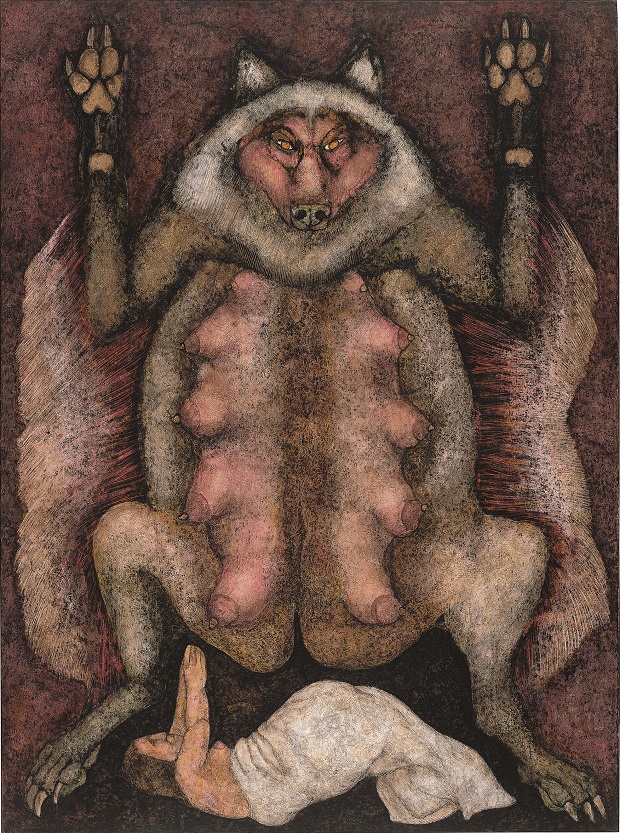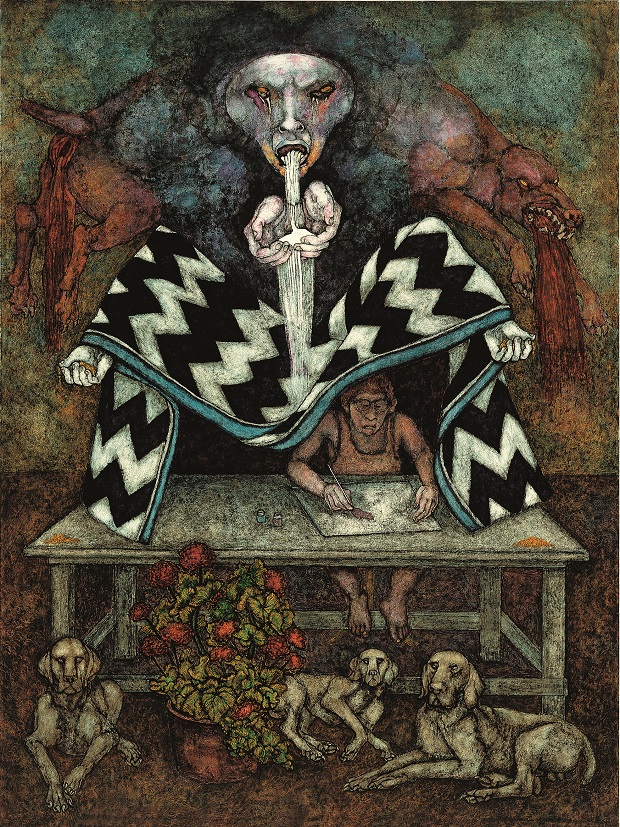|
|
||||||
| home | exhibitions | interviews | features | profiles | webprojects | archive | ||||||
|
Meinrad Craighead and the Animal Face of God Mat Osmond
It’s a memorable passage. But it’s her friend’s
off-hand reply to his own question: ‘Dunno, Great Mother, or something’,
that’s stayed with me. Jamie’s pared-back notion of prayer, eloquent as
it is, left me looking for a way to respond in kind. I see I’m not
really in step with her dismissal of a Who – or perhaps whos – on the
other side of prayer. So I wanted to search for another understanding of
how we might approach art practice, as well as our own immediate
experience, in terms of prayer.
Something in her waters Before I could read, when words were only sounds, not yet ciphers in a book, when words arrived as melodies to my ears before my eyes could decipher them, I heard a word which forever made of word, water and God one round whole. Lying with my dog beneath blue hydrangeas in my grandmother’s garden, shaded against a hot Arkansas afternoon, what I heard within my little girl body was the sound of rushing water. And in the roar, ebbing and fowing as I listened, a word: Come. And I knew that the watery word was God.1 Meinrad Craighead (born Charlene Craighead, 1936) is an American painter and writer whose unusual artistic career has included 14 years living as a Benedictine nun at Stanbrook Abbey, England, where she received the name Sister Meinrad on entering Holy Orders. Craighead’s life and work have been coloured, first to last, by an intense religiosity – in particular, by her lifelong sense of encounter with the unmistakeably feminine presence which first flooded into her child mind during the experience she recounts above. Whatever happened to the young Charlene on that
hot summer afternoon, the memory of it has run like a central current
through her adult life, and has remained foundational to her
understanding of herself as an artist. As she herself once put it, ‘It
was water that frst told me I was an artist, and I believed the water.’
And whatever or whoever it was that this upwelling rush of water frst
introduced her to, its sustained influence on her life has been closely
associated, at all times, with her intimations of The passages from Craighead’s memoirs in this refection span her long life. They lead us from that abrupt childhood awakening to the year she spent alone, aged 28, drawing beside the mountain shrine of La Moreneta, the Black Madonna of Montserrat in Catalonia. They track her eventual return from monastic life in England to the desert landscape of New Mexico. It was there that Craighead recognised, in the face of Crow Mother2, the immanent feminine presence who had shadowed her since childhood. What interests me here, in particular, is how and why this mingled current of sacred presence and sacred landscape has manifested itself within Craighead’s imagery as a mutating flux of animal or half-animal figures, shifting personifcations of the ‘animal mysteries’ towards which she’s understood herself to be in lifelong pilgrimage.
If a forest is a metaphor for the unknown, a drawing is the stroke-by-stroke journey through the unknown: a laying this in, a wiping that out, all the time watching for the image to take shape and lead you into its very specific story. The image begins to give itself to you; you follow it, you serve it. Hence the kinship of making and prayer manifests, with each evoking and shaping the other, creating images which walk right out of the emptiness which has contained them. First, though, a word about angels. In his 2011
essay Angels Talking Back and New Organs of Perception, the Dutch
anthropologist Jan van Boeckel offers a rough – and clearly leaky –
distinction ‘between two basic orientations in the way the natural
environment is approached’ by artists who work within an ecological
paradigm. On the one hand, Boeckel notes practices that involve the
cultivation of new organs of perception: that approach art-making as a
process which ‘nourishes a state of receptivity’, where the artists
adopt an ‘observant, minimally interfering, and attentive’ attitude to
their environment. On the other hand, Boeckel considers a category of
practice he names ‘angels talking back’: ways of working which lead the
artist into ‘an active engagement with the circumambient universe’, that
one way or another involve them in a ‘dynamic, open-ended immersion in a
fundamentally improvisational undertaking’.
It was at Monserrat that I first understood Crow Mother’s fierce presence moving within a Black Madonna. Although I had been in Italy for some years, away from the land of New Mexico, I was never not there, for the spirits of that land clung to me in dreams, in memories, and in the animals sacred to the spirituality of its native peoples. There in the semi-darkness, I stood before La Moreneta, the Little Black Virgin of Monserrat. This daily rhythm – walking up the mountain, walking down to my bell tower – shaped the solitude of those months, as if I were inhaling the silence and exhaling the potent darkness into the charcoal drawings. The double spiral of beginning-midpoint-ending imprinted each day as the phases of the moon imprinted the nights. So how, then, might Hillman read Craighead’s
assertion of the ‘kinship of making and prayer’, and what connectivity
might he observe between her imagery and her engagement with landscape?
It’s just such a root connectivity between imagination, prayer and the
‘circumambient world’ that Hillman proposes in his seminal essay ‘The
Thought of the Heart’, in which he reflects on the classical notion of
the heart: both of what the heart is, and of what the heart does. Before
he can get to this, though, he first has to set out our own prevailing
stories about the heart: those accreted fantasies which have, he
suggests, long ‘held the heart captive’ in Western culture.
In dreams we go down, as if
pushed down into our depths by the hands of God. Pushed down and planted
in our own inner land, the roots suck, the bulb swells. In her depths
everything grows in silence, grows up, breaking the horizon into light.
We rise up as flowers to float on the line between the above and the
below, creatures of both places. She who gives the dream ripens the
seeds which fly in the air and float in the water. Here, crucially, the heart is not understood to be an organ of feeling, but an organ of sight. A way of seeing. And the mode of seeing peculiar to this classical notion of the heart is that which arises through images: through the spontaneous movement of images within the mind. The kind of seeing which arises, in other words, through imagination. Hillman proposes Corbin’s studies on himma as the foundation stone for a renewed culture of imagination, whose first principles declare ‘that the thought of the heart is the thought of images, that the heart is the seat of imagination, that imagination is the authentic voice of the heart, so that if we speak from the heart we must speak imaginatively.’ An animal mode of refection The movement towards pilgrimage begins as a hunch, perhaps a vague curiosity. We cannot anticipate these whispers, but we do hear them, and the numen aroused has teeth in it. Thus a quest is initiated, and we are compelled or shoved into the place of possible epiphanies.
An animal mode of refection Among the many aspects of James Hillman’s
reading of himma that illuminate what’s going on in Meinrad’s
Craighead’s work, perhaps foremost is his take on why this heart of
imagination is shown, mythologically, as In himma, then, we meet imagination as something continuous with the ‘sheen and lustre’ of the phenomenal world. In the self-presenting display of imagination, we see ‘the play of its lights rather than the light of the consciousness that [we] bring to it’. And just as we might say of the animal heart that it ‘directly intends, senses, and responds as a unitary whole’, so this upwelling of imagination within the human mind presents us with a mode of ‘mental refection foreshortened to animal reflex’. But where does all this leave intimacy? What about the vulnerable interiority of the personal, feeling heart? Hillman suggests that in returning the heart to its rightful place as the seat of imagination, we release intimacy itself ‘from confession into immediacy’. What the animal in the heart brings, he tells us, is ‘the courage of immediate intimacy, not merely with ourselves, but with the particular faces of the sensate world with which our heart is in rapport’. Surely this sits right at the centre of what the arts have long held out to us? That rather than being specific to human relationships, intimacy is a quality of being which pervades all aspects of our lived experience, something intrinsic to the fathomless imaginal body within which we inhere.3 This ‘animal in the heart’ seems, at any rate,
to illuminate the intimate species of seeing-though-imagination at work
in Meinread Craighead’s paintings. Not the bending-back of ironic,
critical refection, nor any sophisticated interrogation of form and
language. What we meet in Craighead’s work, as she reaches out towards
The Black Madonna, towards Crow Mother, forever stuck on the mutating
face of her animal God, is something simpler than that. It’s something
more urgent – more needy, even – than the disembodied conceptual
athletics that characterize Kathleen Jamie – along with many others of
course, East and West – offers a notion of prayer as a close attention
to our own direct experience – to caring for and maintaining, as she
puts it, ‘the web of our noticing’. Here in himma, in the heart’s
‘animal awareness to the face of things’, James Hillman retrieves a
valuable name for the more indirect manner of noticing that Meinrad
Craighead’s improvised icons invite us to. And if Craighead’s lifelong
imaginal recuperation can be understood as a form of prayer, then
perhaps such prayer is also, in its own way, an attentiveness – a paying
heed. As Hillman says of the instinctive intelligence which himma
restores to our wayward human behaviours: ‘In the blood of the animal is
an archetypal mind, a mindfulness, a carefulness in
Sources
Mat Osmond is a visual artist and writer based in Falmouth, Cornwall, where he teaches on Falmouth University’s MA Illustration: Authorial Practice course. He’s currently working with the artist Kate Walters on an illustrated poetry pamphlet, Black Light, and on a new essay for the Dark Mountain Project, Greenstone Axe, both of which concern what it might mean to address God as Mother. His ongoing series of poems responding to the work of Meinrad Craighead, O Fountain Mouth, were published in Issue 5 of Anima: Poems of Soul & Spirit, in August 2018. More of his work can be found here: www.strandlinebooks.co.uk |
||||||
|
|


